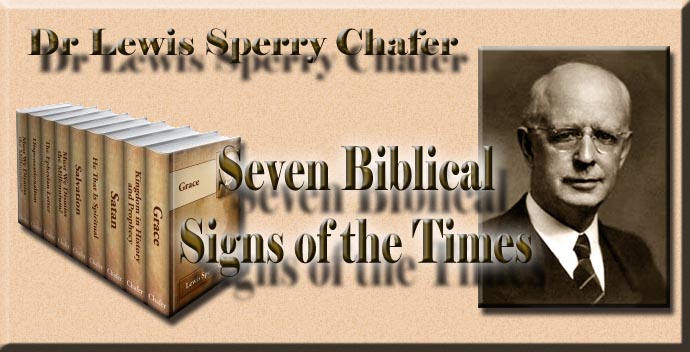
Seven Biblical Signs of the Times
By Lewis Sperry Chafer
Chapter 7 - Sign 2
II. THE GENTILE GOVERNMENT SIGNDaniel was given to see from his own day until the setting up of Messiah’s kingdom in the earth.[1] This period Christ termed, “The times of the Gentiles” (Luke 21:24). It began with the dispersion of Israel from her land and continues until her King returns and re-establishes her in her own everlasting kingdom. It is characterized by Gentile over-lordship, Israel’s absence from the land, and her beloved city being trodden down by Gentiles. Two revelations concerning this period were given to Daniel. One was through his interpretation of Nebuchadnezzar’s dream, recorded in chapter two; the other was through his own dream, recorded in chapter seven. Nebuchadnezzar’s dream was of a colossal image in four different metal sections. Daniel’s dream was of four beasts. The four sections of the image and the four beasts exactly correspond and represent four successive Gentile world-empires that were to be. From a careful study of these, and other Scriptures, we conclude that these empires are, Babylon, Media-Persia, Greece (under Alexander), and Rome. The Roman portion is divided by the two legs of the image. So the Roman Empire was divided into its Eastern and Western divisions. Finally there are ten toes to this image, as there are ten horns to the last beast. The following is Daniel’s interpretation of the king’s dream. (The whole context should be studied):
At the extremity of this image, there are feet and toes which are of iron mingled with brittle clay. This, we are told, is also a manifestation of a form of Gentile government. In this form of government the people do not cleave one to the 'other as iron and clay are not mixed. This is a picture of democracy, or individualism, in government as opposed to autocracy, — the autocracy represented in the successive sections of the great image. If all this be true, and history permits of no other interpretation, this prophecy teaches that the “times of the Gentiles” will end with the return of Christ at the time when democracy is established in the earth; for it is in the days of these ten-toe governments over the divided territory of the old Roman Empire that the God of heaven will set up His everlasting kingdom in the earth. What do we now see? It has long seemed almost impossible that many of the imperial governments of Europe could ever become democratic; but it is now accomplished. A more or less uncertain and feeble form of democratic rule is now being exercised over the territory of the Roman Empire as well as over the whole world. Men are not cleaving one to another. There is no final unit of government that ignores the individual and subordinates him against his will. In democracy the individual is the sovereign. The present adjustment of Europe, we may believe, is being guided by an unseen hand; for the very boundaries of the Roman Empire are re-appearing. The prophecy of Daniel indicates that the shattering blow to the whole fabric of Gentile government by the return of Christ is not far removed. “For when they shall say Peace and safety; then sudden destruction cometh upon them, as travail upon a woman with child; and they shall not escape.”
|
||
|
||
| [1] Abraham saw from his day about 430 years to the deliverance of his family out of Egypt (Gen. 15:13-16). Moses took up the vision where Abraham’s vision ceased and saw about 1000 years from the delivery of the people from Egypt to the great dispersion, 500 years before Christ (Deuteronomy 28). Both Abraham and Moses saw the yet future and final establishment of the people in their land under the covenant blessings of God (Gen. 13:15; Deut. 30:1-10). Where Moses’ vision ceased, Daniel’s vision began. He completed the prophecy to the “cutting off of Messiah.” Daniel discloses but little detail from the cutting off of Messiah to the end of Gentile rule. He predicts the conditions immediately preceding the end of the Gentile period and also sees the setting up of Messiah’s glorious reign in the earth. The details of the time from the cutting off of Messiah to His return are presented by Christ (Matthew 13. Note, “world” should read “age” in Matt. 13:22, 39-40, 49). |
-
Site Navigation
 Home
Home What's New
What's New Bible
Bible Photos
Photos Hiking
Hiking E-Books
E-Books Genealogy
Genealogy Profile
Free Plug-ins You May Need
Profile
Free Plug-ins You May Need
 Get Java
Get Java.png) Get Flash
Get Flash Get 7-Zip
Get 7-Zip Get Acrobat Reader
Get Acrobat Reader Get TheWORD
Get TheWORD

